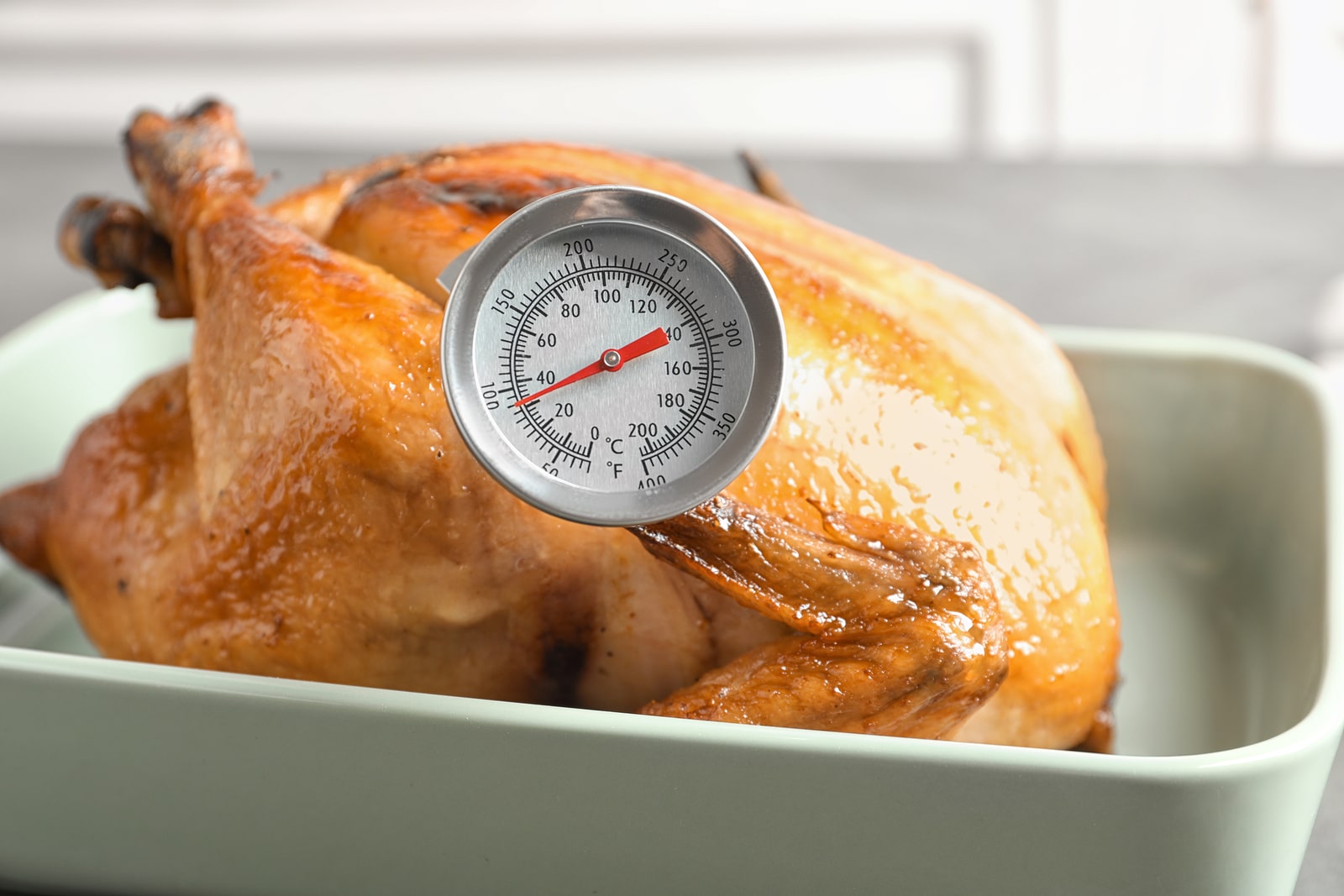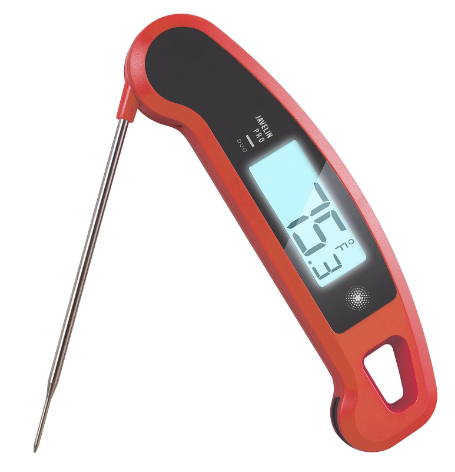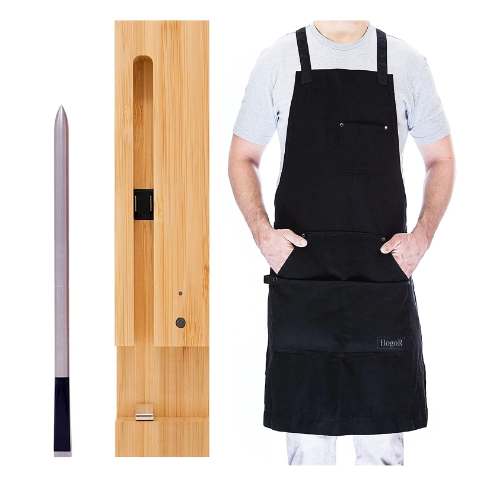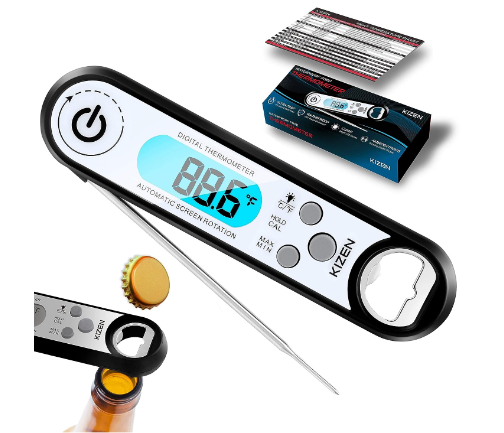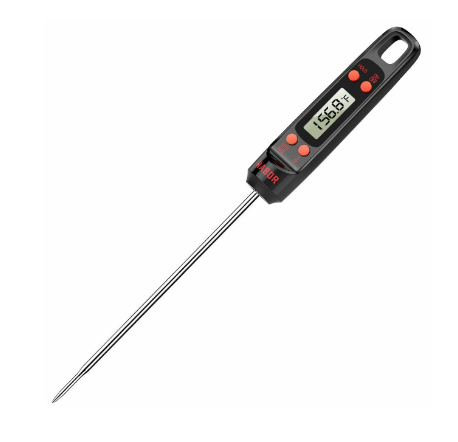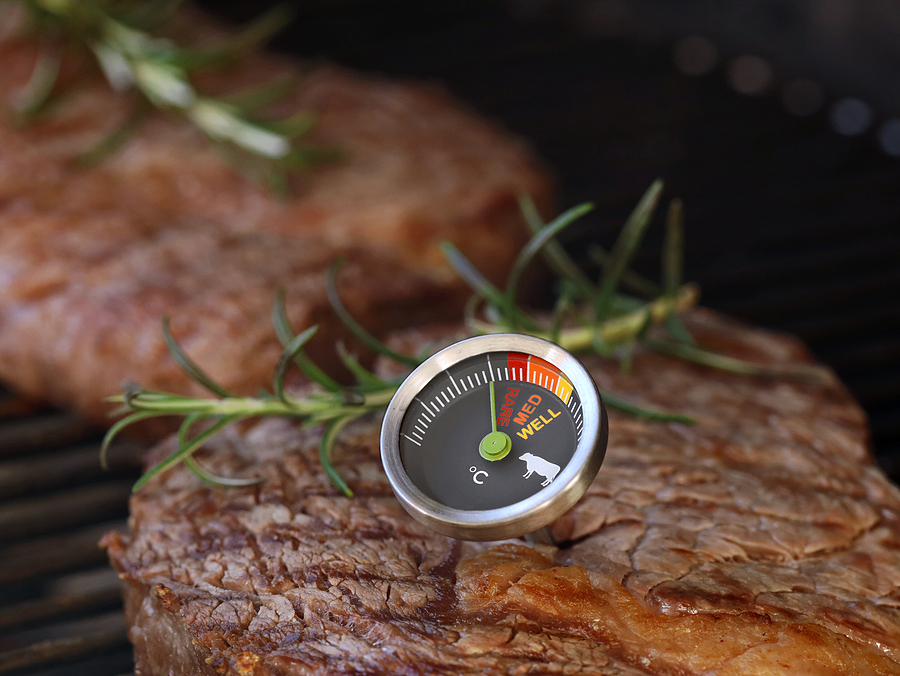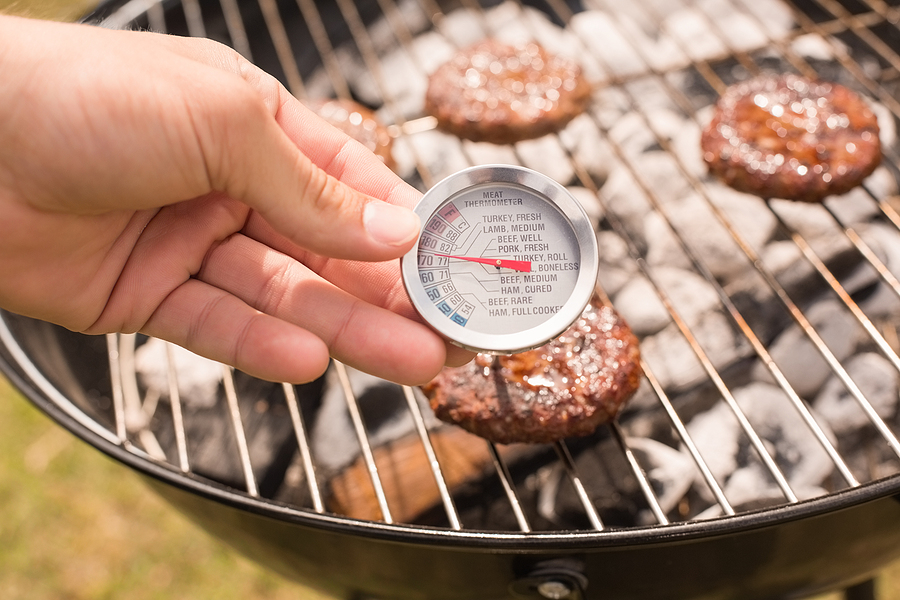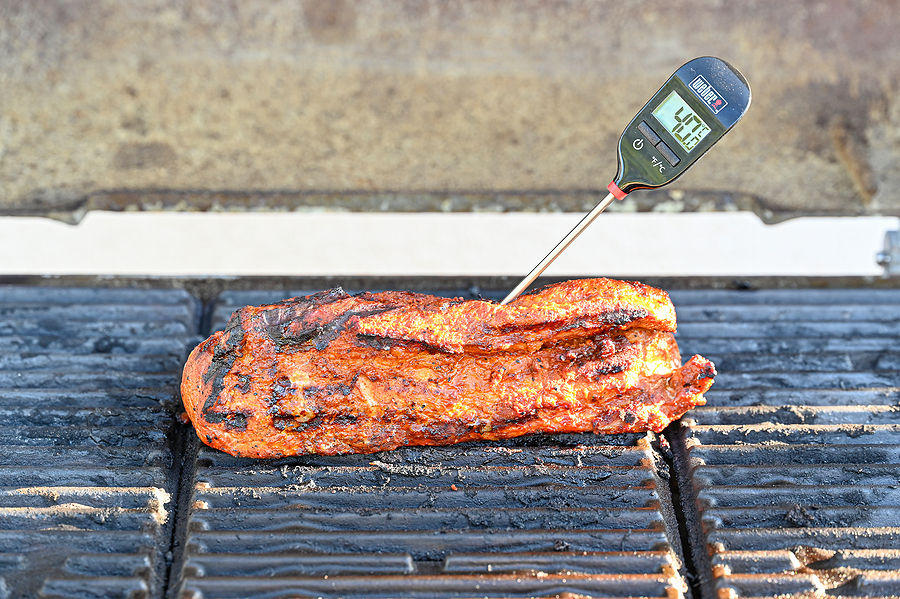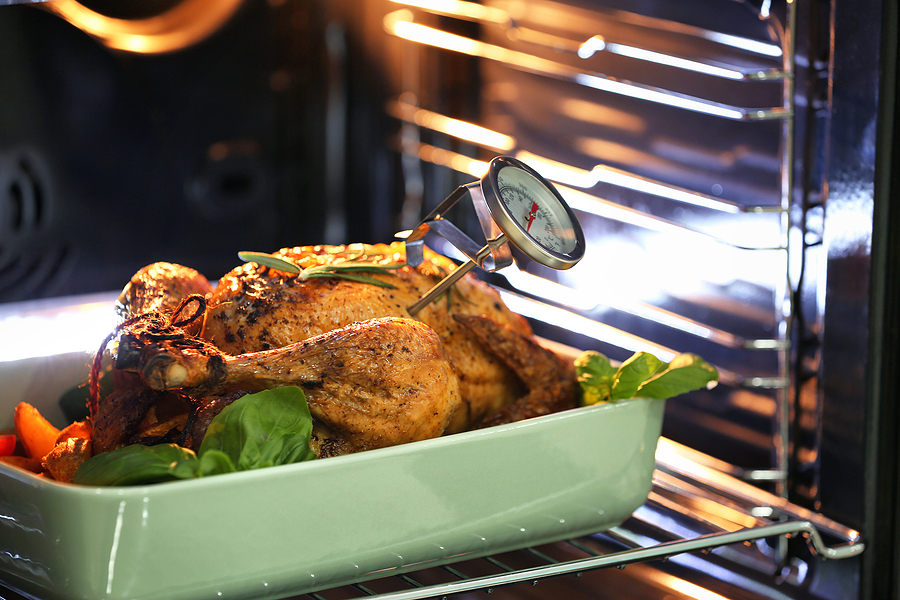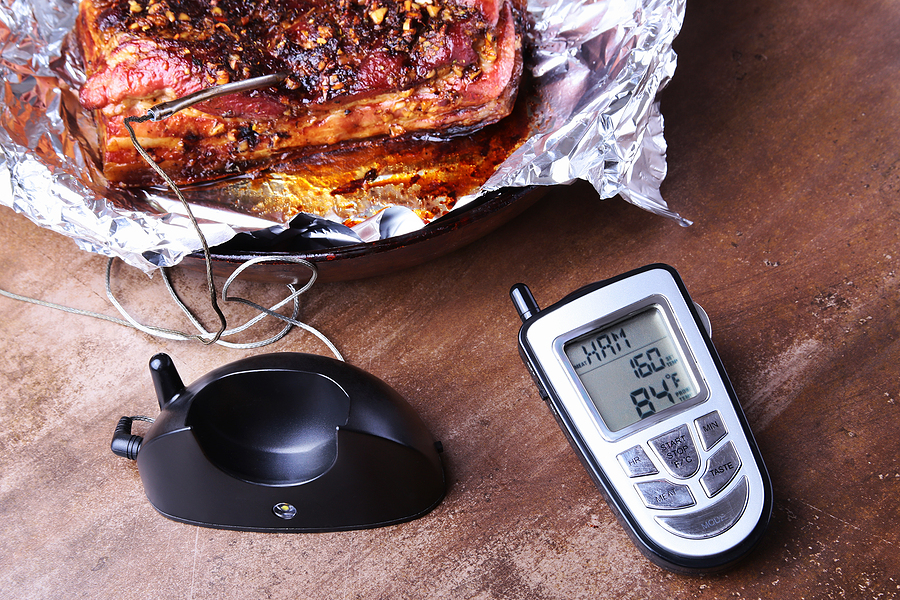A meat thermometer is essential for any cook who wants to ensure their meat is cooked perfectly every time. This handy gadget measures the internal temperature of meat, allowing you to determine whether it is cooked to your desired level of doneness. Whether you are grilling, roasting, or smoking meat, a meat thermometer is a must-have kitchen accessory.
Many different types of meat thermometers are available on the market, each with unique features and benefits. Some are digital, while others are analog. Some are designed to be inserted into the meat while it is cooking, while others can be used to measure the temperature of the meat from a distance. No matter the meat thermometer you choose, it is essential to use it correctly to ensure your heart is cooked safely and to your liking.
Top Picks for Meat Thermometers
1. ThermoPro TP03 Digital Instant Read Meat Thermometer
The ThermoPro TP03 Digital Instant Read Meat Thermometer is popular and highly rated. It has a fast and accurate reading with a 3-4 seconds response time and can measure temperatures up to 572°F. The thermometer also has a large LCD that shows the temperature clearly and a hold function that allows you to lock the temperature reading on the screen.
The ThermoPro TP03 is designed with a foldable probe that makes it easy to store, and it also has a magnetic back that allows you to attach it to metal surfaces for easy access. The thermometer is powered by a single AAA battery included in the package. The ThermoPro TP03 is a reliable, affordable meat thermometer perfect for home use. It is easy to use, accurate, durable, and can withstand regular use.
Features of ThermoPro TP03 Digital Instant Read Meat Thermometer
- Fast and accurate readings: The thermometer provides a quick and precise temperature reading in 3-4 seconds, with an accuracy of ±0.9°F.
-
Large and clear display: The large LCD is easy to read, even in low light conditions, and shows the temperature in both Fahrenheit and Celsius.
-
Temperature range: The thermometer can measure temperatures from -58°F to 572°F (-50°C to 300°C), making it suitable for a wide range of cooking applications.
-
Foldable probe: The 3.9-inch stainless steel probe is foldable, making it easy to store in a compact space, and also helps to protect the investigation from damage.
-
Hold function: The thermometer has a hold function that allows you to lock the temperature reading on the screen, making it easier to read and record.
-
Auto-off function: The thermometer has an auto-off role that helps to conserve battery life by turning off the device after 10 minutes of inactivity.
-
Magnetic back: The thermometer has a magnetic back that allows you to attach it to metal surfaces for easy access.
-
Battery life: The thermometer is powered by a single AAA battery, included in the package, and has a life of up to 4,000 hours.
Here are some pros and cons of the ThermoPro TP03 Digital Instant Read Meat Thermometer:
Pros:
- Fast and accurate readings: The ThermoPro TP03 provides a quick and precise temperature reading in just 3-4 seconds, which helps to ensure that your meat is cooked to perfection.
- Easy to use: The thermometer is very simple to use, with a straightforward interface and intuitive controls.
- Large and clear display: The large LCD is easy to read, even in low light conditions, and shows the temperature in both Fahrenheit and Celsius.
- Foldable probe: The foldable search makes it easy to store the thermometer in a compact space and also helps to protect the investigation from damage.
- Affordable: The ThermoPro TP03 is affordable, making it an excellent choice for home cooks on a budget.
Cons:
- Not waterproof: The ThermoPro TP03 is not waterproof, so it may not be suitable for use in wet conditions.
- Limited temperature range: The thermometer can only measure temperatures up to 572°F, which may not be sufficient for some types of cooking.
- No automatic shut-off: The thermometer has no automatic shut-off feature, so you must remember to turn it off after use to conserve battery life.
- Battery life: The battery life of the thermometer may be shorter than expected, mainly if used frequently.
2. Lavatools Javelin PRO Duo Ambidextrous Backlit Instant Read Digital Meat Thermometer
The Lavatools Javelin PRO Duo is a high-quality digital meat thermometer that provides quick and accurate temperature readings for your cooking needs. Its ambidextrous design allows for easy use by left- and right-handed individuals and the backlit display ensures easy tasks even in low-light conditions.
The thermometer also features a waterproof and impact-resistant exterior, making it durable and long-lasting. With its fast response time and high accuracy, the Lavatools Javelin PRO Duo is an excellent tool for any home cook or professional chef.
The Lavatools Javelin PRO Duo Ambidextrous Backlit Instant Read Digital Meat Thermometer features include:
- Quick and accurate temperature readings: The thermometer provides fast and precise temperature readings within 1-3 seconds.
- Ambidextrous design: The thermometer is designed to be used by both left and right-handed individuals, making it easy to use for everyone.
- The thermometer has a backlit display that makes it easy to read, even in low-light conditions.
- Waterproof and impact-resistant exterior: The thermometer has a waterproof and impact-resistant body that makes it durable and long-lasting.
- Fast response time: The thermometer quickly responds, providing temperature readings quickly.
- Temperature range: The thermometer has a temperature range of -40°F to 572°F (-40°C to 300°C), which is suitable for a wide range of cooking applications.
- Calibration feature: The thermometer has a calibration feature that allows you to adjust the temperature readings if needed.
- Battery life: The thermometer has a long battery life, so you won’t have to replace the batteries frequently.
- Automatic shut-off: The thermometer has an automatic shut-off feature that helps to conserve battery life.
Here are some pros and cons of the Lavatools Javelin PRO Duo Ambidextrous Backlit Instant Read Digital Meat Thermometer
Pros:
- Quick and accurate temperature readings
- Ambidextrous design for easy use by both left and right-handed individuals
- Backlit display for easy task in low-light conditions
- Waterproof and impact-resistant exterior for durability and longevity
- Fast response time
Cons:
- Higher price point compared to some other digital meat thermometers on the market
- Some users may find the thermometer to be a bit bulky or heavy
- Limited temperature range compared to some other meat thermometers, with a maximum temperature of 572°F (300°C)
3. MEATER Plus Long Range Smart Wireless Meat Thermometer
The MEATER Plus Long Range Smart Wireless Meat Thermometer is a high-tech cooking tool that allows you to monitor the temperature of your meat from a distance. It features a wireless design that connects to your smartphone or tablet via Bluetooth or Wi-Fi, allowing you to track the temperature of your meat in real time.
The thermometer also has a long-range capability, meaning you can monitor your meat up to 165 feet away. Additionally, the MEATER Plus comes with a companion app that provides cooking guides and recipes for various types of meat. With its advanced features and user-friendly design, the MEATER Plus is an excellent tool for home cooks and professional chefs.
The MEATER Plus Long Range Smart Wireless Meat Thermometer features include:
- Wireless design: The thermometer is designed to be wireless, allowing you to monitor the temperature of your meat from a distance.
- Long-range capability: The thermometer has a long-range capacity of up to 165 feet, meaning you can monitor your meat from a considerable distance.
- Companion app: The thermometer comes with a companion app that provides cooking guides and recipes for various types of meat.
- Advanced features: The thermometer has advanced features, such as the ability to set custom alerts and timers, which make it easy to cook your meat to perfection.
- User-friendly design: The thermometer is designed to be user-friendly, with a simple interface that is easy to use.
- Dual temperature sensors: The thermometer has dual temperature sensors that allow you to monitor the internal temperature of your meat and the ambient temperature of your grill or oven.
- Rechargeable battery: The thermometer has a rechargeable battery that provides up to 24 hours of continuous use.
- Magnetic charging dock: The thermometer has a magnetic charging dock that makes it easy to charge the device.
- Automatic shut-off: The thermometer has an automatic shut-off feature that helps to conserve battery life.
Here are some pros and cons of the MEATER Plus Long Range Smart Wireless Meat Thermometer
Pros:
- Wireless design allows you to monitor the temperature of your meat from a distance
- Long-range capability of up to 165 feet
- The companion app provides cooking guides and recipes for various types of meat
- Advanced features, such as the ability to set custom alerts and timers
- User-friendly design that is easy to use
Cons:
- Higher price point compared to some other meat thermometers on the market
- Requires a smartphone or tablet to use, which may not be convenient for some users
- Bluetooth or Wi-Fi connectivity may be unreliable in some areas or with some devices
- Some users may find the thermometer to be a bit complex to set up and use initially
- Limited temperature range compared to some other meat thermometers, with a maximum temperature of 212°F (100°C)
4. Kizen Instant Read Meat Thermometer
The Kizen Instant Read Meat Thermometer is a simple yet effective cooking tool that provides quick and accurate temperature readings for your meat. It features a compact design that is easy to use and store and provides temperature readings within 2-3 seconds. The thermometer also has a wide temperature range, making it suitable for various cooking applications.
The Kizen Instant Read Meat Thermometer also features a waterproof and durable exterior, making it long-lasting and easy to clean. With its affordable price point and user-friendly design, the Kizen Instant Read Meat Thermometer is an excellent choice for home cooks and grill masters alike.
The Kizen Instant Read Meat Thermometer features include:
- Quick and accurate temperature readings: The thermometer provides fast and precise temperature readings within 2-3 seconds.
- Compact design: The thermometer is compact and easy to use and store.
- Wide temperature range: The thermometer has a wide temperature range of -58°F to 572°F (-50°C to 300°C), making it suitable for a variety of cooking applications.
- Affordable price point: The thermometer is cheaper than other meat thermometers on the market.
- Waterproof and durable exterior: The thermometer has a waterproof and durable surface that is easy to clean and long-lasting.
- Easy to use: The thermometer is designed to be user-friendly, with a simple interface that is easy to read and understand.
- Automatic shut-off: The thermometer has an automatic shut-off feature that helps to conserve battery life.
- Calibration feature: The thermometer has a calibration feature that allows you to adjust the temperature readings if needed.
- Backlit display: Some thermometer models have a backlit display that makes it easy to read in low-light conditions.
Here are some pros and cons of the Kizen Instant Read Meat Thermometer
Pros:
- Quick and accurate temperature readings within 2-3 seconds
- Compact design that is easy to use and store
- Wide temperature range suitable for a variety of cooking applications
- Affordable price point compared to some other meat thermometers on the market
- Waterproof and durable exterior that is easy to clean
Cons:
- It does not have as many advanced features as other meat thermometers on the market.
- It has no long-range capability, so you must be close to your meat to monitor the temperature.
- Some users may find the thermometer a bit small or complex to read.
- Limited temperature range compared to some other meat thermometers, with a maximum temperature of 572°F (300°C)
5. Habor Digital Meat Thermometer
The Habor Digital Meat Thermometer is a budget-friendly cooking tool that provides accurate temperature readings for your meat. It features a simple, user-friendly design that is easy to use and provides temperature readings within 4-6 seconds. The thermometer also has a wide temperature range, making it suitable for various cooking applications.
The Habor Digital Meat Thermometer also features a foldable probe design, making it easy to store and transport. With its affordable price point and convenient method, the Habor Digital Meat Thermometer is an excellent option for home cooks and grill enthusiasts on a budget.
The Habor Digital Meat Thermometer features include:
- Budget-friendly price point: The thermometer is affordable compared to many other meat thermometers on the market.
- Simple and user-friendly design: The thermometer is designed to be easy to use, with a simple interface and a foldable probe for easy storage and transport.
- Accurate temperature readings: The thermometer provides accurate temperature readings within 4-6 seconds.
- Wide temperature range: The thermometer has a wide temperature range of -58°F to 572°F (-50°C to 300°C), making it suitable for a variety of cooking applications.
- Automatic shut-off: The thermometer has an automatic shut-off feature that helps to conserve battery life.
- Easy to clean: The thermometer is easy to clean, with a waterproof and durable exterior.
- Celsius/Fahrenheit switchable: The thermometer allows you to switch between Celsius and Fahrenheit readings.
Here are some pros and cons of the Habor Digital Meat Thermometer
Pros:
- Budget-friendly price point
- Simple and user-friendly design that is easy to use
- Accurate temperature readings within 4-6 seconds
- Foldable probe design that is easy to store and transport
Cons:
- It does not have as many advanced features as other meat thermometers on the market.
- It has no long-range capability, so you must be close to your meat to monitor the temperature.
- Some users may find the thermometer to be a bit basic or flimsy.
- Limited temperature range compared to some other meat thermometers, with a maximum temperature of 572°F (300°C)
Understanding Meat Thermometers
Meat thermometers are a must-have tool for anyone who wants to cook meat perfectly. They measure the internal temperature of the heart to ensure that it is cooked to a safe temperature and is tender and juicy. There are two main types of meat thermometers: analog and digital. Analog thermometers have a dial that shows the temperature, while digital thermometers display the temperature on an LCD screen. Digital thermometers are more accurate and easier to read but are also more expensive.
Meat thermometers can be inserted into the meat in different ways, depending on the type of thermometer. Some thermometers have a probe inserted into the heart, while others have a long stem inserted into the meat. It is essential to insert the thermometer into the thickest part of the meat, away from any bones, to get an accurate reading. Meat thermometers can be calibrated to ensure that they are correct. A thermometer should be placed in a glass of ice water to calibrate. The thermometer should read 32 degrees Fahrenheit. It should be adjusted according to the manufacturer’s instructions if it does not.
In summary, meat thermometers are essential for anyone who wants to cook meat perfectly. They come in analog and digital varieties and can be inserted into the heart differently. It is necessary to calibrate the thermometer to ensure accuracy.
Types of Meat Thermometers
There are several types of meat thermometers available in the market. Each type has its unique features and benefits. This section will discuss the most common types of meat thermometers.
- Digital Thermometers – Digital thermometers are the most popular type of meat thermometer. They are easy to use and provide accurate readings within seconds. Digital thermometers can be inserted into the meat and display the temperature on a digital screen. Some digital thermometers come with a probe that can be inserted into the heart and left in while it cooks. This allows you to monitor the temperature without opening the oven or grill.
- Dial Thermometers – Dial thermometers are another common type of meat thermometer. They have a metal probe inserted into the meat and a dial displaying the temperature. Dial thermometers are easy to use and do not require batteries. However, digital thermometers may be more accurate.
- Disposable Thermometers – Disposable thermometers are convenient for those who do not want to invest in a meat thermometer. They are typically made of paper and can be inserted into the meat. The thermometer will change color when the heart has reached the desired temperature. However, disposable thermometers may not be as accurate as other meat thermometers.
- Pop-up Thermometers – Pop-up thermometers are commonly found in turkeys and other significant cuts of meat. They are designed to pop up when the heart has reached the desired temperature. Pop-up thermometers are easy to use but may not be as accurate as other meat thermometers.
Several types of meat thermometers are available in the market. Digital thermometers are the most popular and provide accurate readings within seconds. Dial thermometers are easy to use and do not require batteries. Disposable thermometers are convenient for those who do not want to invest in a meat thermometer. Pop-up thermometers are commonly found in turkeys and other significant cuts of meat.
How to Properly Use a Meat Thermometer
A meat thermometer is essential to ensure your meat is cooked correctly. Here are the steps to follow when using a meat thermometer:
- Insert the Thermometer: Insert the thermometer into the thickest part of the meat, ensuring it does not touch any bones or the pan.
- Wait for the Temperature: Wait for the thermometer to register the temperature. This can take a few seconds to a few minutes, depending on the thermometer you use.
- Check the Temperature: Once the thermometer has registered the temperature, remove it from the meat and check the temperature reading. Make sure to read the temperature at eye level to ensure accuracy.
- Determine Doneness: Use a temperature chart to determine the proper temperature for the type of meat you are cooking and the level of doneness you desire.
- Let the Meat Rest: After removing the meat from the heat source, rest for a few minutes to allow the juices to redistribute.
It is essential to clean your meat thermometer after each use to prevent cross-contamination. Clean the thermometer with hot, soapy water and sanitize it with a solution of one part vinegar to one part water.
By following these simple steps, you can ensure that your meat is always cooked to perfection.
Benefits of Using a Meat Thermometer
A meat thermometer is a kitchen tool that measures the internal temperature of meat, ensuring it is cooked to a safe temperature. A meat thermometer has several benefits, making it an essential tool for any home cook or professional chef.
Ensures Safety
One of the most significant benefits of using a meat thermometer is ensuring food safety. The thermometer allows the cook to determine whether the meat has reached the appropriate temperature, which is crucial for killing harmful bacteria that can cause foodborne illnesses. The USDA recommends cooking meats to specific temperatures to ensure they are safe. For example, ground beef should be cooked to an internal temperature of 160°F (71°C), while chicken should be cooked to 165°F (74°C). A meat thermometer makes it easy to check the internal temperature of the meat, ensuring that it is safe to eat.
Prevents Overcooking
Another benefit of using a meat thermometer is that it prevents overcooking. Overcooked meat can be tricky and dry, making eating less enjoyable. With a meat thermometer, the cook can remove the meat from the heat source when it reaches the desired internal temperature, ensuring it is perfectly cooked. This is especially important when cooking expensive cuts of meat, as overcooking can ruin the texture and flavor.
Improves Flavor
Using a meat thermometer can also improve the flavor of the meat. When meat is cooked to the proper temperature, it retains moisture, resulting in a juicy and flavorful dish. On the other hand, overcooked beef can be dry and tough, resulting in a less enjoyable eating experience. The cook can use a meat thermometer to ensure the meat is cooked to the perfect temperature, resulting in a delicious and satisfying meal.
In conclusion, using a meat thermometer has several benefits, making it an essential tool for any home cook or professional chef. It ensures food safety, prevents overcooking, and improves the flavor of the meat. Cooks can create delicious and safe meals that impress their guests using a meat thermometer.
Choosing the Right Meat Thermometer
A meat thermometer ensures it is cooked to the right temperature, making it safe and delicious. However, with so many types of meat thermometers available in the market, it can take time to choose the right one. Here are some factors to consider when selecting a meat thermometer:
- Type of Thermometer – Various meat thermometers are available, including digital, analog, instant-read, and leave-in. Digital thermometers are the most popular as they are easy to read and provide accurate readings. Analog thermometers, conversely, are less expensive but can be challenging to read and may need to be more precise. Instant-read thermometers are handy for quickly checking the temperature of the meat, while leave-in thermometers are ideal for slow-cooked meats.
- Temperature Range – Different types of meat require different cooking temperatures. Therefore, choosing a thermometer that can measure the temperature range needed for the meat you are cooking is essential. For example, a thermometer measuring temperatures up to 500°F is suitable for grilling. In contrast, a thermometer that can measure temperatures as low as 32°F is ideal for measuring the temperature of frozen meat.
- Probe Length – The probe length is essential when choosing a meat thermometer. The probe size should be long enough to reach the center of the meat without touching the bone. A more extended probe is also helpful for measuring the temperature of more significant cuts of beef.
- Accuracy – Accuracy is crucial when it comes to cooking meat. A thermometer that is not accurate can result in undercooked or overcooked meat, which can be dangerous or disagreeable. Therefore, choosing a precise thermometer that provides consistent readings is essential.
- Ease of Use – A meat thermometer should be easy to use, read, and clean. A thermometer with a large display, easy-to-read numbers, and simple buttons is ideal. It should also be easy to clean and store.
In conclusion, choosing a suitable meat thermometer ensures your meat is perfectly cooked. By considering the type of thermometer, temperature range, probe length, accuracy, and ease of use, you can select a thermometer that meets your needs and helps you cook delicious and safe meat.
Cleaning and Maintenance
Proper cleaning and maintenance of a meat thermometer are essential to ensure its accuracy and longevity. Here are some tips to keep your thermometer in good condition:
- Clean after each use: After each use, clean the thermometer with a damp cloth or sponge. Do not immerse the thermometer in water or put it in the dishwasher, which can damage the electronic components.
- Calibrate regularly: Calibrate the thermometer regularly to ensure its accuracy. This can be done by placing the thermometer in ice water (32°F/0°C) and adjusting the reading to 32°F/0°C. Alternatively, you can use boiling water (212°F/100°C) and adapt the lesson to 212°F/100°C.
- Replace batteries: If your thermometer uses batteries, replace them as needed. A low battery can affect the accuracy of the thermometer.
- Store properly: Store the thermometer in a dry and cool place. Do not expose it to extreme temperatures or direct sunlight, which can damage the electronic components.
- Use a protective case: Use a protective case to protect the thermometer from damage during storage or transport.
Following these simple tips ensures that your meat thermometer remains accurate and reliable for years.
Common Mistakes to Avoid
When using a meat thermometer, there are some common mistakes that people make that can affect the accuracy of the readings. Here are a few things to avoid:
1. Not Calibrating the Thermometer – One of the most common mistakes is not calibrating the thermometer before use. A thermometer not calibrated can give inaccurate readings, resulting in undercooked or overcooked meat. To avoid this, it is essential to calibrate the thermometer regularly.
2. Not Inserting the Thermometer Correctly – Another common mistake is not inserting the thermometer correctly. The thermometer should be inserted into the thickest part of the meat, away from any bones, fat, or gristle. If the thermometer is inserted into a bone or a fatty area, it can give an inaccurate reading.
3. Not Waiting for the Reading – Many people make the mistake of not waiting for the thermometer to give a reading. Waiting for the thermometer to stabilize and provide an accurate reading is essential. Pulling the thermometer out too soon can result in an inaccurate reading, leading to undercooked or overcooked meat.
4. Not Cleaning the Thermometer – It is essential to clean the thermometer after each use to prevent cross-contamination. Many people forget to clean the thermometer, which can lead to the spread of harmful bacteria. To clean the thermometer, wipe it down with a damp cloth and sanitize it with water and vinegar.
5. Not Using the Thermometer at the Right Time – Finally, many people need to start using the thermometer at the right time. Using the thermometer at the right time is essential for an accurate reading. For example, if you use the thermometer too early, the meat may need to be cooked more; if it is too late, it may be overcooked.
By avoiding these common mistakes, you can ensure your meat is always perfectly cooked.
Conclusion
In conclusion, a meat thermometer is essential for any home cook or professional chef. It ensures that meat is cooked to the desired temperature, reducing the risk of foodborne illness and ensuring that the meat is cooked to perfection. Many types of meat thermometers are available on the market, each with advantages and disadvantages. Digital thermometers are the most popular due to their accuracy and ease of use, while analog thermometers are a more traditional option.
When choosing a meat thermometer, it is essential to consider factors such as temperature range, response time, and accuracy. Choosing a thermometer that is easy to clean and use is also necessary. Overall, a meat thermometer is a small investment that can make a big difference in the quality and safety of your cooking. Whether you are grilling, roasting, or frying meat, a thermometer is a must-have tool that will help you achieve perfect results every time.

